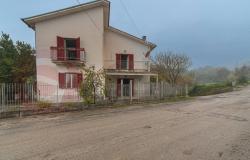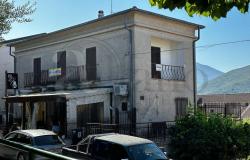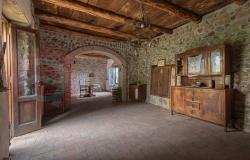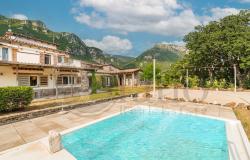The road - the Costiera - from Saint Agata sui Due Golfi to Vietri sul Mare was begun in 1853 under orders from Ferdinand II. It is some 45 miles in length and on the map it looks much like any other road. Driving it is a different story. Hewn out of solid rock with very few guardrails, in places you need to have a steeplejack’s head for heights, even in a car, and it makes more twists and turns than a politician being pressed on future taxation policy. But then, this narrow corniche road is worth the occasional ‘how the hell did we miss him’ moment because it takes you along the most heart-stoppingly beautiful stretch of coast scenery in the entire Med. Except if you are the one driving, it’s probably best not to look at the view! Unless you’re stationary, of course. And in summer you could well be. The road is quietest in early afternoon, always busy at weekends, and on summer nights it’s often full of ravers on their way to and from the discos of Salerno.
What strikes you first about this landscape is its ability to defy gravity. Crags rise from the sea, gnarled, bleached, and in places clothed in forests, dark even under a Campanian sun. The towns seem to hang from the rock like belayed climbers forcing a new route up an extreme and hitherto unclimbed face. Viewed from any angle, the houses, dozing in the sun, seem about to relax their grip on the rock and slide into the sea. Nor is this image an entirely fanciful one. Did not much of Amalfi do just that during a storm in 1343?
Needless to say, a coastline this spellbinding attracts the wealthy; a summer place here is de rigueur for many well-off Romans, and a stroll round the shops at Positano, for instance, will confirm that when it comes to chic, this seemingly out-of-the-way bit of Italy is right up there with what is di moda. And, of course, in the summer there is no getting away from the fact that this is very much coach-party country; indeed, should a few such parties hit town at the same time, the streets can look as if a crowd for a big league local derby footie match has turned up. Nature, when it comes this grand, can never be exclusive, but the crowds that flock to the area are very much birds of passage, passing through in the summer months, leaving spring and autumn quieter.
Leaving Naples
Driving out from Naples, perhaps having overdosed on what remains of the glory that was Herculaneum and Pompeii, and having spent time in dear old congenial Sorrento - and after Naples the inside of a rugby scrum is serene - the first town on the road of a ‘thousand bends’ you encounter is Positano. And your first glimpse of the place will make you understand why the writers of travel brochures and guide books have expended acres of purple prose trying to describe it. Well, this is one hack who will not raid his Thesaurus to add to all those acres; suffice to say that with Positano, nature and man have combined to produce a scene that is so beautiful that it will echo and re-echo in your mind’s eye long years after you have left it. However, if you are driving, finding a place to park will be something you will almost certainly want to forget. In short, park if you see a space and walk down in to the town – look out for steps if you do this, they’ll get you to the shore quicker than if you keep to the cork-screwing road.
The ‘main’ road continues its chicaning way east, still determined to put years on you, until, just beyond Praiano – a place that anywhere else would be regarded as a scenic jewel but here it is merely a pearl – you come to the Furore Gorge. On either side of this mighty cleft are tiny sea-hugging communities that defy the tourist to reach them by any other means except boat, whilst just beyond it is a lift that takes you down to the Grotta Smeralda, so named because of the way that the sea produces a green light in it. Next is Conca dei Marini – a village piled up on itself that is, by this coast’s standards at least, almost quiet.
Two miles further on you come to Amalfi, a town so lovely that the locals have placed a sign over the square around the harbour that reads:
will be a day like any other day.’
Well, if paradise is like Amalfi, some of us will hope that they will have sorted out the parking before we get there. Still, you can forgive the locals their pride – by any standards this is a place of almost impossible beauty, the town and its setting as near to perfection as anywhere on earth. If you feel energetic, a trek up a long flight of steps to the cathedral is well worth the effort – it is probably the best in all of the south, better even than those on Sicily, whose Arab-Norman style of architecture it copies. As a building, it reminds you of Spain, its Muslim influence understandable when you remember that Amalfi once had trading links with that country. Outside, its façade – with its four levels of striped arches and the open arches of the porch – is either whimsical or visionary, depending on your point of view. The cathedral’s great glory, however, is its bronze doors with their cast portraits of Christ, Mary,
St Peter and St Andrew, the town’s patron. Made in Constantinople in 1066 and signed by the craftsman, Simon of Syria, they were commissioned by the Amalfitan colony there and were the first doors of their kind in Italy.
Back on the main road you go through the village of Atrani, whose church boasts yet another set of bronze doors from Constantinople, but whose chief glory is a Byzantine relief of a pair of peacocks standing on a man and a rabbit - curious or what?
Beyond Atrani you should take the road inland off the main road to Ravello, but be aware that once there, parking is again hellish and can really cost you. Cost you yes, but who can put a price on the reckless beauty of the views down over the coast? If you can manage another cathedral there is one, but for most visitors the very thought of going indoors is a no-no – seeking out the man-made when nature is as lovely as she is at Ravello seems almost perverse. Better to spend time visiting the gardens of the Villa Cimbrone and the Villa Rùfolo, both of which command spectacular views over the coast. The gardens at the Villa Rùfolo have another claim to fame, for they fired the imagination of a great composer of opera; sadly though, not the likes of Verdi or Bellini, but rather one Richard Wagner, a composer of very un-Italian music.
Continuing on our way, our drive is almost over. Minori is the next town encountered. It has somehow managed to avoid being swamped by tourism, though every year seems to bring more development. For the time being it remains a rather understated, pleasant town; understated, that is, when compared to its ravishingly lovely neighbours. Next is Maiori, a seasidey, modern sort of town – its true self having been washed away in a flood in 1954 – and soon the dream of heaven is shattered as the port of Salerno looms into view. However, there is still the town of Vietri sul Mare to come. Famous for its majolica, it has something of the sleepiness and beauty of the towns back along the way, but with its plethora of ceramic shops everywhere, you kind of get the feeling that if you have not exactly been expelled from paradise, you are pretty near the back door.













